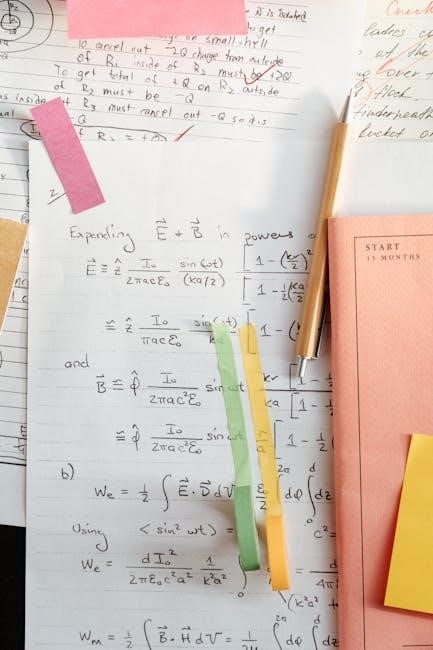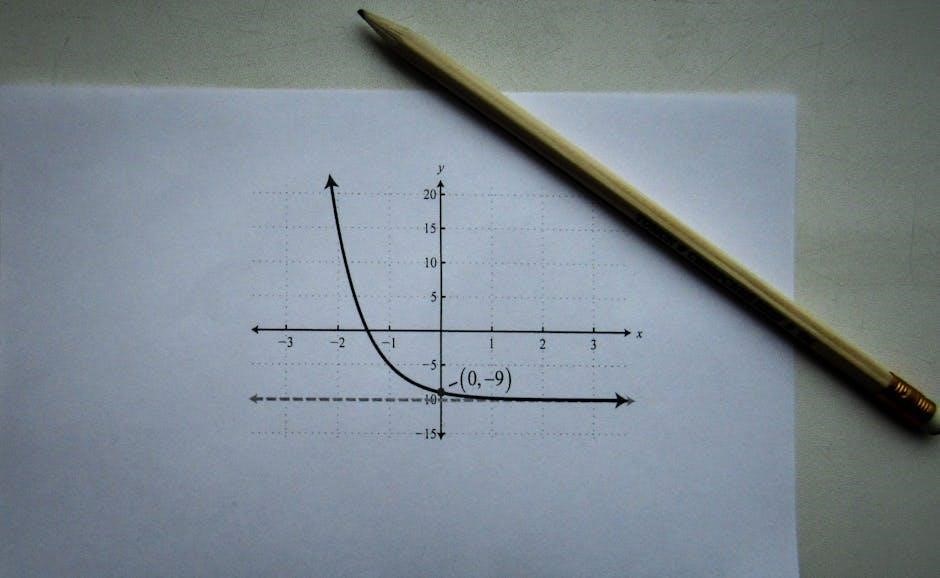linear equations word problems worksheet pdf
Linear equations word problems involve translating real-world scenarios into mathematical expressions. They require identifying variables, setting up equations, and solving for unknowns, enhancing problem-solving skills and real-world application understanding.
What Are Linear Equations?
A linear equation is a first-degree polynomial equation where the highest power of the variable is 1. It can be expressed in the form ( ax + b = 0 ), where ( a ) and ( b ) are constants, and ( x ) is the variable. Linear equations graph as straight lines on a coordinate plane, making them fundamental in modeling real-world scenarios, such as cost calculations, distance-speed-time problems, and budget planning. They are essential tools for solving word problems, as they simplify complex situations into mathematical expressions that can be easily manipulated and solved.
Importance of Word Problems in Learning Linear Equations
Importance of Word Problems in Learning Linear Equations
Word problems are essential for applying linear equations to real-life situations, bridging the gap between abstract math and practical scenarios. They enhance critical thinking and problem-solving skills by requiring students to interpret and translate language into mathematical expressions. Solving word problems builds confidence in manipulating variables and constants, preparing learners for advanced math and science. Regular practice with word problems improves the ability to identify patterns, understand relationships, and make informed decisions in fields like finance, engineering, and physics. They also foster a deeper understanding of linear equations by connecting them to tangible, everyday contexts.

Setting Up Linear Equations from Word Problems
Setting up linear equations from word problems involves identifying variables and constants, translating English sentences into mathematical expressions, and structuring equations based on the problem’s context.
Identifying Variables and Constants
Identifying variables and constants is the first step in translating word problems into mathematical equations. Variables represent unknown values, such as x or y, while constants are fixed numbers. Key phrases like “more than,” “less than,” or “twice” help determine relationships. For example, in problems involving costs, the total cost might be a base fee (constant) plus a variable rate per item. Accurately identifying these elements ensures the equation accurately reflects the problem, making it easier to solve using algebraic methods or graphical representations.
Translating English Sentences into Mathematical Expressions
Translating English sentences into mathematical expressions is a critical skill for solving word problems. Key phrases like “more than,” “less than,” or “twice” indicate addition, subtraction, or multiplication. For example, “5 more than x” becomes x + 5, while “twice a number” is 2x. Constants, such as fixed fees or total amounts, are directly translated into numbers. Variables represent unknowns, often denoted by letters like x or y. Accurate translation ensures the equation aligns with the problem’s context, enabling effective solving using algebraic methods or graphical tools.

Solving Linear Equation Word Problems
Solving linear equation word problems involves using algebraic methods to isolate variables. Techniques include substitution, elimination, and graphical approaches. Verification through substitution ensures solutions are accurate and valid.
Using Algebraic Methods
Solving linear equation word problems often involves algebraic techniques like substitution or elimination. These methods help isolate variables, making it easier to find unknown values; For instance, in problems involving costs or distances, setting up equations based on given rates and totals allows for systematic solving. Step-by-step simplification ensures clarity, while verification through substitution confirms the accuracy of solutions. Algebraic methods are versatile and reliable, providing a clear pathway to unravel complex scenarios presented in word problems. Regular practice enhances proficiency in translating real-world situations into solvable mathematical expressions. This approach builds a strong foundation for tackling more advanced problems in the future.
Graphical and Tabular Representations
Graphical and tabular methods complement algebraic solutions by providing visual insights. Graphs of linear equations can reveal trends and relationships, while tables organize data systematically. These tools aid in understanding how variables interact, especially in problems involving rates or multiple steps. For example, plotting distance over time helps visualize motion scenarios. Tables can list values for variables like cost or speed, making patterns more apparent. These methods are particularly useful for verifying solutions and exploring “what-if” scenarios, enhancing both comprehension and problem-solving efficiency. They bridge the gap between abstract equations and tangible, real-world applications, making complex problems more accessible and engaging for learners. Regular use of these representations fosters a deeper understanding of linear relationships and their practical implications.
Real-World Applications of Linear Equations
Linear equations are essential in financial planning, budgeting, and distance-speed-time problems. They model real-world scenarios, aiding in forecasting, resource allocation, and optimization across various industries, from economics to engineering.
Financial Planning and Budgeting

Linear equations are invaluable in financial planning and budgeting, enabling individuals and businesses to model expenses, income, and savings. For instance, a delivery service charging a base fee plus a per-package rate can be represented by a linear equation, helping calculate total costs. Similarly, savings plans, like Alice saving $5 weekly, can be modeled to determine future savings amounts. These equations allow for forecasting, budget adjustments, and informed decision-making, ensuring financial goals are met efficiently. Practical applications include calculating total costs for services, understanding savings growth over time, and making data-driven financial decisions.
Distance, Speed, and Time Problems
Linear equations are essential for solving distance, speed, and time problems. For example, a taxi service charging a fixed fee plus a rate per mile can be modeled with a linear equation to calculate total costs for trips. These problems often involve determining rates, such as calculating average speed or total distance traveled. Word problems may ask for the time required to cover a certain distance at a given speed or the total cost of a journey. By setting up and solving linear equations, individuals can forecast travel expenses, optimize routes, and make informed decisions about transportation and budgeting. These applications highlight the practical use of linear equations in real-world scenarios.

Common Mistakes and Tips for Avoiding Them
Common mistakes include misidentifying variables, misinterpreting key phrases, and arithmetic errors. Tips for avoiding them involve reading problems carefully, verifying solutions, and practicing consistently to build accuracy.
Understanding Key Phrases in Word Problems
Key phrases in word problems often indicate mathematical operations or relationships. For example, “more than” suggests addition, while “less than” implies subtraction. Words like “twice” or “three times” indicate multiplication, and “sum” or “total” denote addition. Phrases such as “combined” or “together” may signal the need to add quantities, whereas “difference” or “remaining” could imply subtraction. Understanding these phrases is crucial for translating word problems into accurate linear equations. Practicing with various problems helps in recognizing these patterns and improving problem-solving skills effectively.
Verifying Solutions Through Substitution
Verifying solutions through substitution ensures the correctness of answers to word problems. After finding a solution, substitute the value back into the original equation to check if both sides are equal. This step confirms the validity of the solution and helps catch any calculation errors. For example, if solving for x in 2x + 5 = 11, substituting x = 3 results in 2(3) + 5 = 11, which simplifies to 11 = 11, verifying the solution. Consistently applying this method builds confidence in problem-solving skills and ensures accurate results, especially in complex word problems or systems of equations.
Practice Problems and Solutions
Practice problems and solutions provide hands-on experience with linear equations. Worksheets offer various scenarios, such as delivery services, taxi fares, and angle problems, with step-by-step explanations and answers.
Sample Worksheets with Answers
Sample worksheets with answers provide structured practice for solving linear equation word problems. Each worksheet includes a variety of scenarios, such as budgeting, geometry, and real-world applications. Problems like calculating delivery costs, taxi fares, and missing angles are common. Step-by-step solutions and final answers are included, allowing learners to verify their work and understand the problem-solving process. These resources are designed to help students master translating words into equations and applying linear equation concepts to practical situations. They are ideal for homework, classwork, or self-study, catering to different learning needs and skill levels.
Step-by-Step Explanations for Complex Problems
Step-by-step explanations for complex linear equation word problems provide detailed guidance for solving challenging scenarios. These explanations break down problems into manageable parts, such as identifying variables, translating sentences into equations, and applying algebraic methods. For example, problems involving multiple variables or real-world contexts, like financial planning or geometry, are solved systematically. Each step is accompanied by clear reasoning, ensuring learners understand how to approach similar problems independently. These explanations are particularly useful for mastering advanced techniques and building confidence in tackling intricate word problems effectively. They are often paired with sample worksheets for comprehensive practice and understanding;